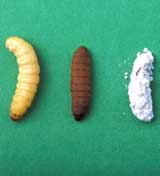
The Genostar consortium today announces the launch of its Genostar platform for exploratory genomics, the result of two and a half years research carried out by a team of more than 20 genomics and bioinformatics scientists and developers. Exploratory genomics involves the study of the structure and function of genes and proteins and plays a vital role in healthcare, agrifood and other industries. Members of the consortium are GENOME express, Hybrigenics, INRIA and the Pasteur Institute (see boilerpla

Scientists at the University of Ulster have unveiled a monitoring system that can ensure transplant organs arrive in pristine condition for the life-saving surgery.
They have developed tiny sensors which are inserted in the organs, and which monitor if there has been any deterioration in the organs’ condition since being removed from the donor.
The sensors are flexible micro-electrodes based on pioneering nanotechnology, which are implanted in the donor organ.
The electrodes mo

Pellets of rotting moths could keep weevils off oranges.
Mummified rotting cadavers could be a cost-effective way to combat soil pests, suggest scientists at the US Department of Agriculture. Citrus crops, cranberries and ornamental shrubs all stand to benefit.
Bacteria in the guts of roundworms grown inside dead wax moths can emerge to kill other soil insects, including the black vine weevil ( Otiorhynchus sulcatus ), a serious pest of plants in nurseries.
Th

A new study using mouse “knockouts” shows that genes that control limb formation in insects have similar functions in mammals.
Split hand/foot malformation (SHFM) or ectrodactyly (the “lobster claw” anomaly), is a severe congenital malformation syndrome characterised by a profound median cleft of the hands and/or feet, typically associated with absence or fusion of the remaining fingers. This condition is quite frequent as about 6 cases of SHFM are observed for every 10,000 human births.

Marine reserves have rapid and lasting impacts on organisms inside reserves, according to scientists at the University of California, Santa Barbara.
In a paper published in the current issue of ECOLOGY LETTERS, the researchers reviewed 80 studies from `no-take` reserves, where it is illegal to extract organisms in any way. These showed that density, biomass, average size and diversity of organisms inside these reserves reach much higher levels within a short period of time, usually one to th

Journal of Biology ( http://www.jbiol.com ) is a new international journal, published by BioMed Central, which provides immediate open access to research articles of exceptional interest. It will only publish research articles of the highest standard, similar to those published by Nature, Science or Cell. While these journals restrict access to only those who pay for a subscription, all research articles published in Journal of Biology will be permanently

– new calculation confirms standard model of particle physics. Contribution of hadronic vacuum polarization determined with unprecedented accuracy. The magnetic moment of the muon is an important precision parameter for…
Technique may prevent formation of unwanted waves that siphon off needed energy. Heating plasma to the ultra-high temperatures needed for fusion reactions requires more than turning the dial on a…

An international team of astronomers, led by researchers from the Astronomical Observatory of the University of Warsaw, have identified a new class of cosmic X-ray sources. The findings have been…

Antibody that Neutralizes Inhibitory Factors Involved in Nerve Regeneration Leads to Enhanced Motor Function after Acute Spinal Cord Injury. Researchers at 13 clinics in Germany, Switzerland, the Czech Republic and…

How the body’s natural killer cells could fight leukemia. Every year, some 13,000 people in Germany are diagnosed with leukemia. Despite intensive chemotherapy, around one in two of them die….

… eco-friendly reactor converts air and water into ammonia. Producing enough ammonia to feed the world comes with a large carbon footprint;. process described in new UB-led study could help…

How simulations help manufacturing of modern displays. Modern materials must be recyclable and sustainable. Consumer electronics is no exception, with organic light-emitting diodes (OLEDs) taking over modern televisions and portable…

“Neurons that fire together, wire together” describes the neural plasticity seen in human brains, but neurons grown in a dish don’t seem to follow these rules. Neurons that are cultured…

The quest for sustainable energy solutions has been a major focus of scientific research for decades. Solar energy, a clean and renewable source, has emerged as a promising alternative to…

With a processing speed a billion times faster than nature, chip-based laser neuron could help advance AI tasks such as pattern recognition and sequence prediction. Researchers have developed a laser-based…

New technology could remotely identify various types of plastics, offering a valuable tool for future monitoring and analysis of oceanic plastic pollution. Researchers have developed a new hyperspectral Raman imaging…

Artificial Intelligence (AI) has established a strong presence across industries, large and small. The “VoBaKI” research project has empowered small and medium-sized enterprises (SMEs) with an innovative tool to independently…